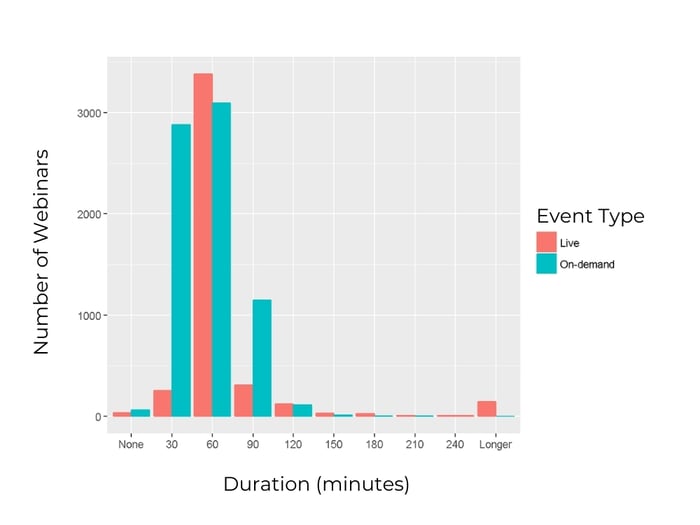Over the past year, we have seen a lot of communication move online. As a result, a lot of businesses have come to the realisation that running webinars is an effective way to engage your audience, increase your lead generation and grow your business.
Despite everyone and their grandmother now creating and running webinars, there are still many common questions people have especially around the planning stages, such as which day is best to run your webinar, should it be streamed live or on-demand and what time of day to broadcast it.
However, one of the most important questions we get asked time and time again by webinar newbies and online event experts is: how long should a webinar be?
The answer: 60 minutes.
An hour is the most popular length for webinars that WorkCast has seen for webinars across all of our customers, both live and on-demand - over 55% of all webinars hosted on WorkCast clocking in at 60 minutes.

Popular with viewers, an hour-long webinar gives you (as the webinar organizer and host) enough time to showcase all the content needed to achieve your goals for that presentation, while not being overly long.
30 minute-long webinars (most of which are viewed on-demand) are also very popular with customers, with 39% of all on-demand webinars hosted on the WorkCast platform being around that length.
The popularity and ubiquity of 60-minute webinars hint that most people (and most marketers) believe hour-long presentations are the ideal webinar length.
However, if we've learned anything over the past year, it's that not all webinars have to be 60 minutes ( just because something is popular doesn't mean it's optimal). When it comes to creating webinars, it's important to keep your audience in mind, and not just create content to hit an arbitrary number.
The length of your webinar shouldn't be dictated by an arbitrary number, rather, you should think about what exactly you want to achieve with each event. If you want to engage your audience on a more regular basis, then shorter and more frequent webinars are more suitable. We’ve seen customers who offer weekly 15-minute events often, perform well with their audience, whereas others drive more engagement with longer, less frequent webinars.
It really depends on what your goals are and what content you want to share. Are you a subject matter expert who wants to create in-depth presentations to an audience looking to expand their knowledge? Then, longer webinars are probably more aligned with your goals. Are you a tech start-up that wants to engage your audience with short, snappy webinars on a regular basis? Then you may only need 15 minutes. The good (and possibly frustrating) thing is it’s entirely up to you.
Although, we do have some audience data that may help you make a more informed decision.
Average Minutes Viewed Per Attendee
As 60 minutes was the most popular webinar length, naturally, our data reflects that most attendees viewed, on average, around 60 minutes of live webinar content.
Live event viewers are also more likely to engage with the live event itself, as they are increasingly likely to attend the session around 10-15 minutes beforehand, download PDFs related to the event, and research relevant topics after the event.
However, when it comes to on-demand content, there is a marked difference in terms of the average minutes viewed by an audience.
When looking at the data, we can see that people attending live events are viewing almost 4 times more content on average, compared to on-demand:
.jpg?width=698&name=Number%20of%20Webinars%20(1).jpg)
What does this show us? Interestingly, if not unsurprisingly, people are more likely to stick with a presentation when it is live. Whether this is due to a feeling of obligation to the live presenter, or because they can flick through on-demand content their leisure, it's not entirely clear. But, what is clear is that this should have some bearing on how long your webinars will be.
So what exactly does this mean for you? Well, like so much about webinars, it depends.
Is your webinar going to be live or on-demand? And if it is live, will it have a life after the live event (i.e. will you make it available on-demand at a later date)?
Hence, if you’re making your webinar available after the initial live stream, you should make the on-demand version of the webinar shorter.
Here are a couple of questions to ask yourself when you're first creating your webinar and are trying to figure out the best length:
- Would a webinar length of around 45 minutes satisfy both live and on demand attendees?
- Could you run several shorter webinars, designed for on-demand viewing, as opposed to one large event?
- Would a larger, multi-session event, such as a virtual conference be a better option?
Think about it, having a webinar long enough for people to feel it’s worthwhile attending live and short enough for on-demand attendees to stick around to view is a brilliant compromise. If you find yourself with more content than you think can fit into 60 minutes, a different type of event may be a better option.
Conclusion
Deciding how long a webinar should last is not as straightforward as you may have hoped.
However, WorkCast’s own data suggests that 60 minutes gives you enough time to include robust content, interactive segments and presentations, while not losing your live audience. It also implies that when your event is viewed on-demand, you’re losing much of the audience after the first 20 minutes due to drop-off.
Dropping 10 to 15 minutes from your webinar is definitely an option, but it’s also important to avoid cutting time when it will negatively affect the quality of your content.
So what can we conclude? It's important to consider both your audience and your content when planning the optimal length of your webinar. One shouldn't supersede the other - they should work together.
A mixture of both live and on-demand events of varying lengths will undoubtedly bring the most success, and it will give your audience a bit variety. Even though this may require some extra effort, remember:
More work = More reward.
Share this
You May Also Like
These Related Stories

26 Essential Webinar Terms

Webinar CPD: Benefits of Using Webinars For Training



